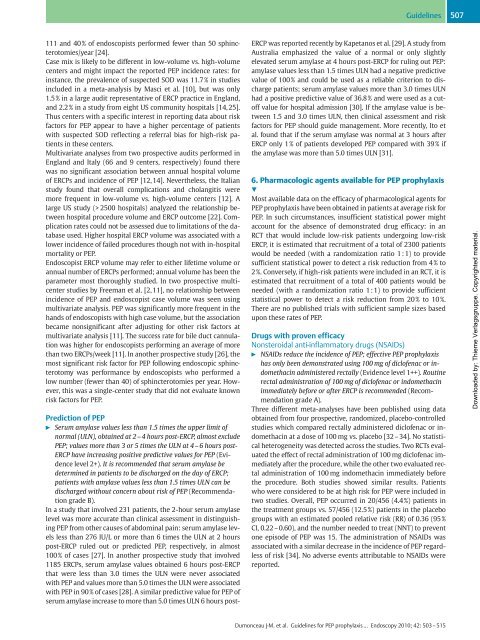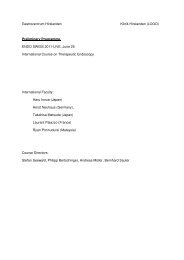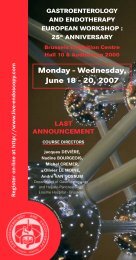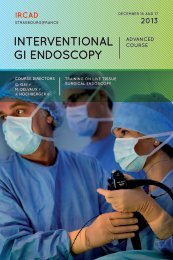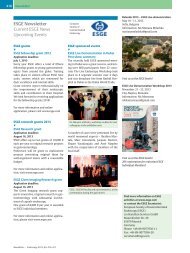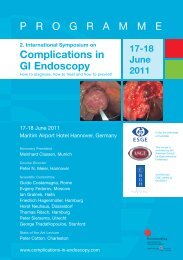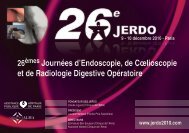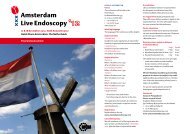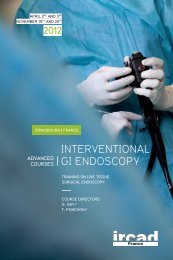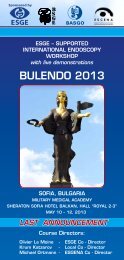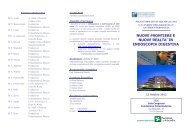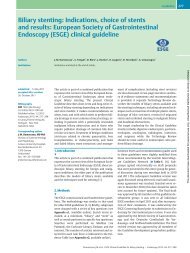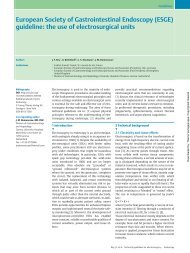(ESGE) Guideline: Prophylaxis of post-ERCP ... - ResearchGate
(ESGE) Guideline: Prophylaxis of post-ERCP ... - ResearchGate
(ESGE) Guideline: Prophylaxis of post-ERCP ... - ResearchGate
Create successful ePaper yourself
Turn your PDF publications into a flip-book with our unique Google optimized e-Paper software.
111 and 40 % <strong>of</strong> endoscopists performed fewer than 50 sphincterotomies/year<br />
[24].<br />
Case mix is likely to be different in low-volume vs. high-volume<br />
centers and might impact the reported PEP incidence rates: for<br />
instance, the prevalence <strong>of</strong> suspected SOD was 11.7 % in studies<br />
included in a meta-analysis by Masci et al. [10], but was only<br />
1.5 % in a large audit representative <strong>of</strong> <strong>ERCP</strong> practice in England,<br />
and 2.2 % in a study from eight US community hospitals [14, 25].<br />
Thus centers with a specific interest in reporting data about risk<br />
factors for PEP appear to have a higher percentage <strong>of</strong> patients<br />
with suspected SOD reflecting a referral bias for high-risk patients<br />
in these centers.<br />
Multivariate analyses from two prospective audits performed in<br />
England and Italy (66 and 9 centers, respectively) found there<br />
was no significant association between annual hospital volume<br />
<strong>of</strong> <strong>ERCP</strong>s and incidence <strong>of</strong> PEP [12, 14]. Nevertheless, the Italian<br />
study found that overall complications and cholangitis were<br />
more frequent in low-volume vs. high-volume centers [12]. A<br />
large US study (> 2500 hospitals) analyzed the relationship between<br />
hospital procedure volume and <strong>ERCP</strong> outcome [22]. Complication<br />
rates could not be assessed due to limitations <strong>of</strong> the database<br />
used. Higher hospital <strong>ERCP</strong> volume was associated with a<br />
lower incidence <strong>of</strong> failed procedures though not with in-hospital<br />
mortality or PEP.<br />
Endoscopist <strong>ERCP</strong> volume may refer to either lifetime volume or<br />
annual number <strong>of</strong> <strong>ERCP</strong>s performed; annual volume has been the<br />
parameter most thoroughly studied. In two prospective multicenter<br />
studies by Freeman et al. [2, 11], no relationship between<br />
incidence <strong>of</strong> PEP and endoscopist case volume was seen using<br />
multivariate analysis. PEP was significantly more frequent in the<br />
hands <strong>of</strong> endoscopists with high case volume, but the association<br />
became nonsignificant after adjusting for other risk factors at<br />
multivariate analysis [11]. The success rate for bile duct cannulation<br />
was higher for endoscopists performing an average <strong>of</strong> more<br />
than two <strong>ERCP</strong>s/week [11]. In another prospective study [26], the<br />
most significant risk factor for PEP following endoscopic sphincterotomy<br />
was performance by endoscopists who performed a<br />
low number (fewer than 40) <strong>of</strong> sphincterotomies per year. However,<br />
this was a single-center study that did not evaluate known<br />
risk factors for PEP.<br />
Prediction <strong>of</strong> PEP<br />
" Serum amylase values less than 1.5 times the upper limit <strong>of</strong><br />
normal (ULN), obtained at 2–4 hours <strong>post</strong>-<strong>ERCP</strong>, almost exclude<br />
PEP; values more than 3 or 5 times the ULN at 4 –6 hours <strong>post</strong>-<br />
<strong>ERCP</strong> have increasing positive predictive values for PEP (Evidence<br />
level 2+). It is recommended that serum amylase be<br />
determined in patients to be discharged on the day <strong>of</strong> <strong>ERCP</strong>;<br />
patients with amylase values less than 1.5 times ULN can be<br />
discharged without concern about risk <strong>of</strong> PEP (Recommendation<br />
grade B).<br />
In a study that involved 231 patients, the 2-hour serum amylase<br />
level was more accurate than clinical assessment in distinguishing<br />
PEP from other causes <strong>of</strong> abdominal pain: serum amylase levels<br />
less than 276 IU/L or more than 6 times the ULN at 2 hours<br />
<strong>post</strong>-<strong>ERCP</strong> ruled out or predicted PEP, respectively, in almost<br />
100 % <strong>of</strong> cases [27]. In another prospective study that involved<br />
1185 <strong>ERCP</strong>s, serum amylase values obtained 6 hours <strong>post</strong>-<strong>ERCP</strong><br />
that were less than 3.0 times the ULN were never associated<br />
with PEP and values more than 5.0 times the ULN were associated<br />
with PEP in 90 % <strong>of</strong> cases [28]. A similar predictive value for PEP <strong>of</strong><br />
serum amylase increase to more than 5.0 times ULN 6 hours <strong>post</strong>-<br />
<strong>Guideline</strong>s 507<br />
<strong>ERCP</strong> was reported recently by Kapetanos et al. [29]. A study from<br />
Australia emphasized the value <strong>of</strong> a normal or only slightly<br />
elevated serum amylase at 4 hours <strong>post</strong>-<strong>ERCP</strong> for ruling out PEP:<br />
amylase values less than 1.5 times ULN had a negative predictive<br />
value <strong>of</strong> 100 % and could be used as a reliable criterion to discharge<br />
patients; serum amylase values more than 3.0 times ULN<br />
had a positive predictive value <strong>of</strong> 36.8% and were used as a cut<strong>of</strong>f<br />
value for hospital admission [30]. If the amylase value is between<br />
1.5 and 3.0 times ULN, then clinical assessment and risk<br />
factors for PEP should guide management. More recently, Ito et<br />
al. found that if the serum amylase was normal at 3 hours after<br />
<strong>ERCP</strong> only 1% <strong>of</strong> patients developed PEP compared with 39 % if<br />
the amylase was more than 5.0 times ULN [31].<br />
6. Pharmacologic agents available for PEP prophylaxis<br />
!<br />
Most available data on the efficacy <strong>of</strong> pharmacological agents for<br />
PEP prophylaxis have been obtained in patients at average risk for<br />
PEP. In such circumstances, insufficient statistical power might<br />
account for the absence <strong>of</strong> demonstrated drug efficacy: in an<br />
RCT that would include low-risk patients undergoing low-risk<br />
<strong>ERCP</strong>, it is estimated that recruitment <strong>of</strong> a total <strong>of</strong> 2300 patients<br />
would be needed (with a randomization ratio 1 : 1) to provide<br />
sufficient statistical power to detect a risk reduction from 4 % to<br />
2%. Conversely, if high-risk patients were included in an RCT, it is<br />
estimated that recruitment <strong>of</strong> a total <strong>of</strong> 400 patients would be<br />
needed (with a randomization ratio 1:1) to provide sufficient<br />
statistical power to detect a risk reduction from 20 % to 10 %.<br />
There are no published trials with sufficient sample sizes based<br />
upon these rates <strong>of</strong> PEP.<br />
Drugs with proven efficacy<br />
Nonsteroidal anti-inflammatory drugs (NSAIDs)<br />
" NSAIDs reduce the incidence <strong>of</strong> PEP; effective PEP prophylaxis<br />
has only been demonstrated using 100 mg <strong>of</strong> dicl<strong>of</strong>enac or indomethacin<br />
administered rectally (Evidence level 1++). Routine<br />
rectal administration <strong>of</strong> 100 mg <strong>of</strong> dicl<strong>of</strong>enac or indomethacin<br />
immediately before or after <strong>ERCP</strong> is recommended (Recommendation<br />
grade A).<br />
Three different meta-analyses have been published using data<br />
obtained from four prospective, randomized, placebo-controlled<br />
studies which compared rectally administered dicl<strong>of</strong>enac or indomethacin<br />
at a dose <strong>of</strong> 100 mg vs. placebo [32 – 34]. No statistical<br />
heterogeneity was detected across the studies. Two RCTs evaluated<br />
the effect <strong>of</strong> rectal administration <strong>of</strong> 100 mg dicl<strong>of</strong>enac immediately<br />
after the procedure, while the other two evaluated rectal<br />
administration <strong>of</strong> 100 mg indomethacin immediately before<br />
the procedure. Both studies showed similar results. Patients<br />
who were considered to be at high risk for PEP were included in<br />
two studies. Overall, PEP occurred in 20/456 (4.4%) patients in<br />
the treatment groups vs. 57/456 (12.5%) patients in the placebo<br />
groups with an estimated pooled relative risk (RR) <strong>of</strong> 0.36 (95 %<br />
CI, 0.22 – 0.60), and the number needed to treat (NNT) to prevent<br />
one episode <strong>of</strong> PEP was 15. The administration <strong>of</strong> NSAIDs was<br />
associated with a similar decrease in the incidence <strong>of</strong> PEP regardless<br />
<strong>of</strong> risk [34]. No adverse events attributable to NSAIDs were<br />
reported.<br />
Dumonceau J-M. et al. <strong>Guideline</strong>s for PEP prophylaxis … Endoscopy 2010; 42: 503 –515<br />
Downloaded by: Thieme Verlagsgruppe. Copyrighted material.


